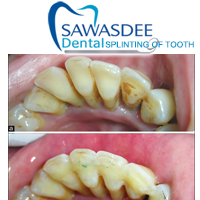- Scaling & root planning
- Correction of overhanging restorations
- Gingivectomy
- Currettage
- Flap surgeries
- Grafting
- Splinting
Gingivectomy :-
 It is periodontal surgery that removes and reforms diseased gum tissue or other gingival buildup related to serio us underlying conditions. For more chronic gingival conditions, gingivectomy is utilized after other non-surgical methods have been tried, and before gum disease has advanced enough to jeopardize the ligaments and bone supporting the teeth. Performed in a dentist's office, the surgery is primarily done one quadrant of the mouth at a time under local anesthetic.
It is periodontal surgery that removes and reforms diseased gum tissue or other gingival buildup related to serio us underlying conditions. For more chronic gingival conditions, gingivectomy is utilized after other non-surgical methods have been tried, and before gum disease has advanced enough to jeopardize the ligaments and bone supporting the teeth. Performed in a dentist's office, the surgery is primarily done one quadrant of the mouth at a time under local anesthetic.
Splinting :-
Treating Mobile Teeth - Splinting of Tooth
 Splinting is nothing but to Join few or more tooth together to prevent mobility of shaky tooth. Usually Splinting is done for Mobile tooth (shaky tooth) after Periodontal Treatment, Avulsed or partially avulsed tooth (tooth that has come out of socket partially or completely eg,. in accidents) or after wearing fixed braces (orthodontic treatment).
Splinting is nothing but to Join few or more tooth together to prevent mobility of shaky tooth. Usually Splinting is done for Mobile tooth (shaky tooth) after Periodontal Treatment, Avulsed or partially avulsed tooth (tooth that has come out of socket partially or completely eg,. in accidents) or after wearing fixed braces (orthodontic treatment).
What happens actually in Splinting treatment?
In Tooth Splinting the Joined tooth are fixed in one place, they cannot move. If the underlying cause for tooth mobility is removed, there are more chances for a better bone to form around the tooth roots, thereby increasing the chances for a tooth to become stable after splinting.
Is Splinting permanent or it can be removed?
It depends on for what reason we are splinting the tooth. For Avulsed (Knocked out) tooth eg.. the upper front tooth- the splinting is normally removed in 6-8 weeks. After Fixed Orthodontics mostly we need to splint the tooth permanently to avoid even mild changes of tooth alignment after the treatment.
How do you splint the tooth?
Previously we used to bond a Metal wire Behind or on the front of the teeth to be splinted. But, Now-a-days , after the introduction of Glass Fibers we use them for Tooth Splinting -as it gives a more Esthetic appearance with its invisible color in the front tooth as well as it has better bonding to the tooth.
Can one take normal food after Splinting?
Yes, if the tooth are properly splinted there will not be any movement of the teeth . But, tearing foods (like chicken)in the splinted tooth should be avoided until there is complete bone formation around splinted tooth roots.
Does all shaky teeth need Splinting?
Mobile tooth are Graded by Dentist as Grade I, Grade II and Grade III.
Grade I – mild mobility in Horozontal direction- if the underlying cause like tatar or the Tooth infection is attended properly the mobility stops.There is no need for splinting.
Grade II- moderate mobility in Horizontal Direction. Eg,. After Periodontal Flap (Gum) surgery .Splinting is needed Temporarily or Permanently.
Grade III – Mobility in Horizontal and Vertical direction .If there is an underlying cause and there is a chance for the mobile tooth to come back to normal condition ,a Proper Treatment is done with Permanent splinting .If the Dentist suspects the Grade III mobile tooth will have a Hopeless condition (Poor Prognosis) ,it has to extracted.






